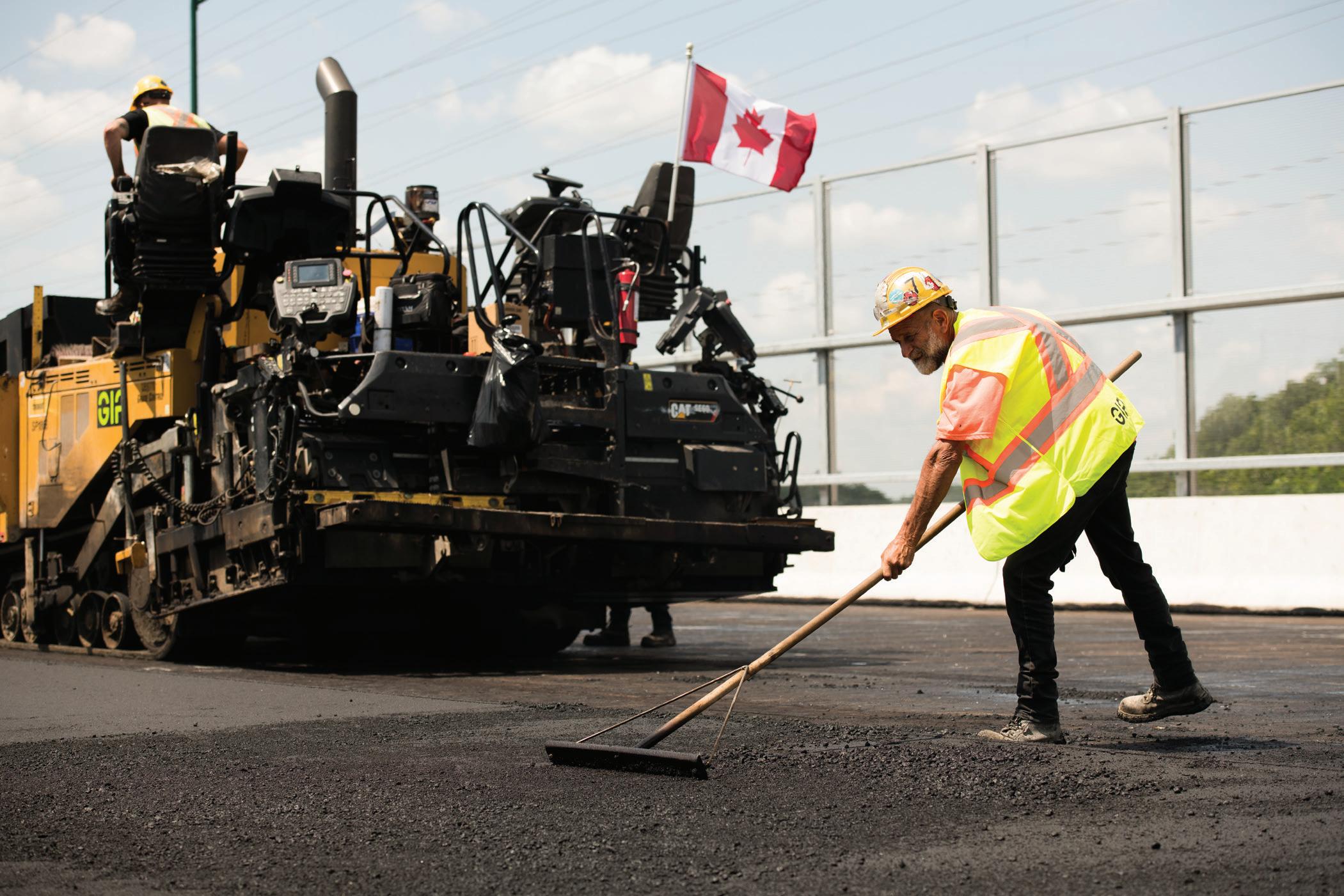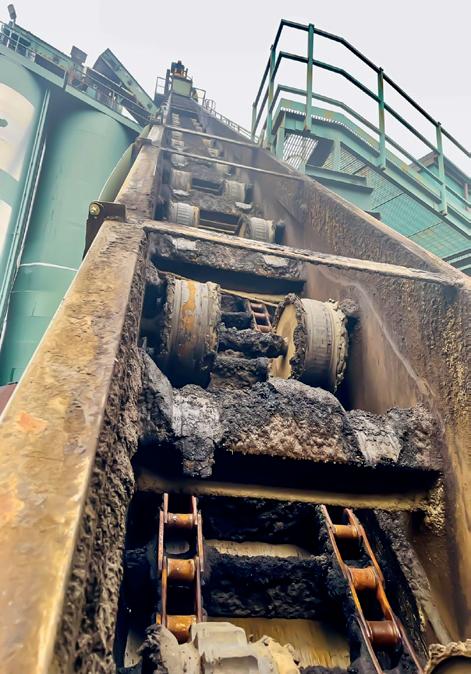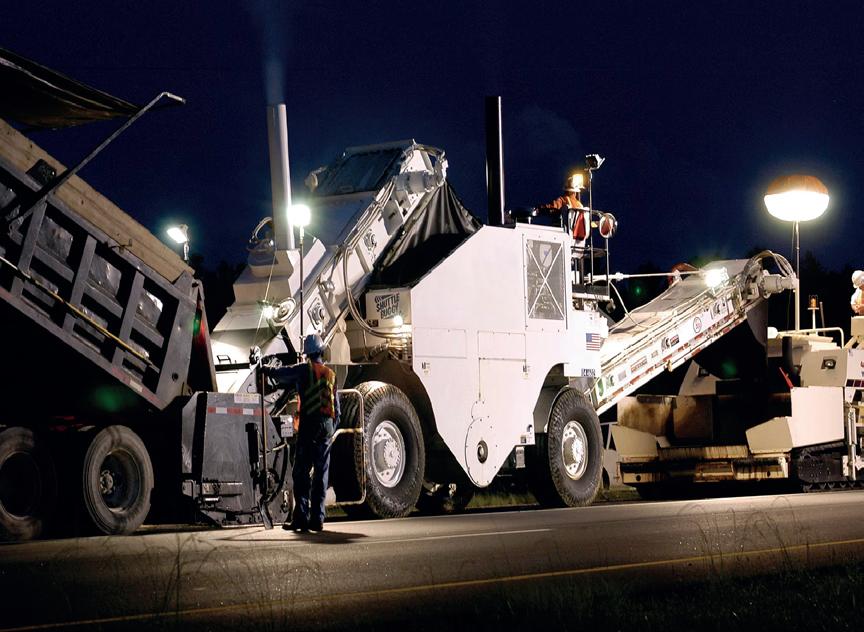














Land Development
Road Construction
Asphalt and Concrete Paving
Milling
Commercial Parking Lot Construction
Sewer & Water Installation and Repairs
Concrete Crushing 4",2",3/4" aggregate
Heavy Equipment Rentals
complete with GPS
Street & Lot Sweeping
Snow Clearing & Sanding Services
Hydro Excavation Services
Design Build




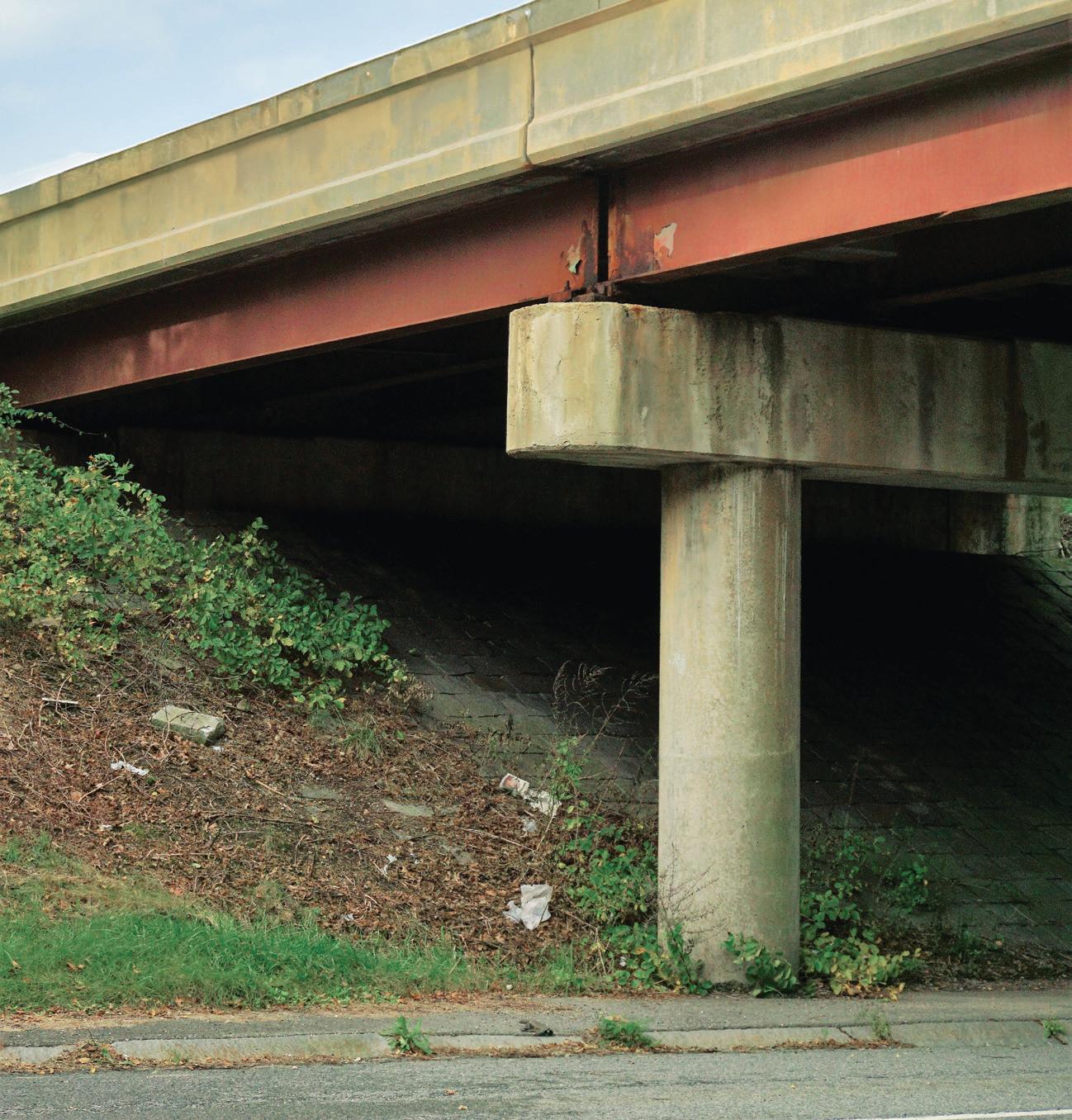
Peter Paulic Brandt Tractor Ltd. IT’S TIME TO MAKE
2024 MHCA BOARD OF DIRECTORS
MHCA EXECUTIVE COMMITTEE
Board Chair Dennis Cruise, CET, G.S.C., Bituminex Paving Ltd.
Vice-Chair Kevin Brown, P.Eng, G.S.C., Maple Leaf Construction Ltd.
Immediate Past Chair Nicole Chabot, B.A., G.S.C., L. Chabot Enterprises Ltd.
Secretary/Treasurer John Highmoor, B.A., B.Sc. (C.E.) Tri-Core Projects Ltd.
President and CEO Chris Lorenc, B.A., LL.B.
EXECUTIVE DIRECTORS AT LARGE
Tony Teixeira J.C. Paving Ltd.
Richard Wilson CET, G.S.C. M.D. Steele Construction Ltd.
BOARD DIRECTORS AT LARGE
Tyler Bennett, M.E.T. Sigfusson Northern Ltd.
Michael Byrne Aon Reed Stenhouse Inc.
Denis Collet B.Comm. Gravier Collet Gravel Inc.
Tina Larson, P. Eng., M. Sc. Lafarge Canada
Marcel Machado B.Sc., C.E. Nelson River Construction
Michelle Magdic BFL Canada Risk and Insurance Services Inc.
Greg McKee SMS Equipment
Jack Meseyton G.S.C. E.F. Moon Construction Ltd.

Advertising Coordinator: Stefanie Hagidiakow
The MHCA is a prominent membership-based advocate for the heavy construction and related industries in Manitoba, representing over 400 contractors, suppliers and financial companies.
Founded in 1943, the MHCA advances progressive public policies and innovative programs in a manner consistent with the broad public interest.
The MHCA serves as the primary ‘go to’ resource for the heavy construction and related industries for information, networking, public policy advocacy and member services.
It promotes sustainable investment in core infrastructure – streets, highways, bridges, water/wastewater systems, active transportation, water-control structures, trade gateways and corridors – to support economic growth and social development that benefits our province and country.
MHCA champions workplace safety education and training through its leading-edge WORKSAFELY® program established in 1990.
It actively participates in local, provincial, regional and national advocacy groups and collaborates extensively with public and private-sector stakeholders to advance common core values, including economic growth, diversity, and safe work, which benefit our communities, province and country.
It has an earned reputation for effective advocacy.


Cities today shoulder unsustainable demand for services. The rising demand for affordable housing, addictions resources and emergency response is piling on. It is making it harder for municipalities to fund other core services, such as road repairs, garbage pickup, fire, police and recreation programs.
Shackled by turn-of-the-century rules on what they can and cannot do to raise revenues, they rely on property taxes and fees. Therefore, they lack the flexibility and capacity to meet the tasks and opportunities cities face in the 21st century.
So, what can they do? How can we enable our cities to move beyond the same old ways of funding and delivering services and become truly great places to live?
It’s time for a new fiscal deal for municipalities, one that pulls apart the fiscal arrangements that provincial legislation set in stone at the beginning of the 20th century.
A big problem is that municipalities get just 10 cents on every tax dollar collected. Provincial transfers, dedicated or global, are decided by provinces with their own list of priorities. Cost-shared infrastructure funding agreements
It’s time for a new fiscal deal for municipalities, one that pulls apart the fiscal arrangements that provincial legislation set in stone at the beginning of the 20th century.
It’s got to change. It has to change because carrying on with the same frustrating and unsustainable model of civic fiscal and financial management means two things: property taxes rise, pinching homeowners; and program budgets are shaved to flow funds to the latest priority or crisis.
That leaves little room for municipalities to think big and devise strategies to grow and attract new businesses and residents because that takes investment.
typically are split evenly three ways despite the fact that municipalities have less muscle to raise revenues.
This issue of Road2Growth looks at the need for a new fiscal deal.
Inside, you’ll see Canada’s authority on the topic – Enid Slack – laying out the problem confronting municipalities. Slack, on pages 12-14, writes from a cross-Canada perspective.
In Manitoba, the MHCA has been pressing for years for negotiations to start on a new fiscal deal. The warm relations between Main Street
and Broadway today provide a conspicuous opening.
There are signs the province may be willing to give ground on taxing authority. Budget 2024 talked about a new model for municipal funding, and it is open to discussing Winnipeg’s proposed tax on cell phones to help fund 911 services.
There are things City Hall can do, as well, to give it more credibility at the negotiation table.
First, it must put economic growth at the centre of all its development strategies – OurWinnipeg, the Transportation Master Plan and the Strategic Priorities Action Plan.
And, equally as important, Winnipeg should create a Chief Economic Development Officer, reporting through the CAO to the Mayor and a Council committee responsible for policies to grow the economy.
Finally, it should use the unrivalled voice it has, as home to 62% of Manitoba’s population and 64% of its economy, to press the Premier and Cabinet to strike a new fiscal deal and unleash Winnipeg’s potential as an economic powerhouse.
That would be a great deal, economically, for all of Manitoba.
 Chris Lorenc, B.A., LL.B. President and CEO, MHCA
Chris Lorenc, B.A., LL.B. President and CEO, MHCA
Members say five of the biggest reasons they value the association are:
1 2
Our members, big and small companies throughout Manitoba, meet and learn from each other at our premier events and by participating in our standing committees, where industry, policy and budget concerns are addressed.
The MHCA is a prominent advocate respected across Manitoba for its informed and progressive approach to shaping public policy. It is often sought out for advice and opinion by media, governments and the public.
3
This directory is the go-to tool used by contractors, suppliers, government and purchasers of all industry services in Manitoba. It includes the annually updated and relied-upon equipment rental rate guide.
4
The MHCA WORKSAFELY® Program, established in 1990, provides workplace safety and education training to reduce workplace incidents. This includes the Certificate of Recognition (COR®) recognized by SAFE Work Manitoba as the required safety training standard.
5
Our weekly newsletter keeps members aware of MHCA activities, events, concerns, advocacy activities and includes tender ads and results.
Are You Interested in Joining?
Visit https://mhca.mb.ca/benefits-of-membership or contact Christine Miller, MHCA Operations Manager, at 204-594-9053 or christine@mhca.mb.ca.
AUGUST
7
OCTOBER
MHCA Golf Classic
22 Economic Growth Forum
NOVEMBER
22
22
MHCA Annual General Meeting
MHCA Chair’s Gala
The Links at Quarry Oaks, Steinbach, MB
Canad Inns Polo Park, Winnipeg, MB
RBC Convention Centre, Winnipeg, MB
RBC Convention Centre, Winnipeg, MB
Be sure to read the Heavy News, check out www.mhca.mb.ca, X (Formerly Twitter), Facebook, Instagram, or contact Christine Miller, Operations Manager, at 204-594-9053 or christine@mhca.mb.ca for information on additional events throughout the year.




Choose your model



MHCA’s publications are widely circulated, reaching the desks of the heavy construction industry, purchasers of its related services, stakeholder and business associations, government leaders, senior decision makers and numerous other government officials at all levels.
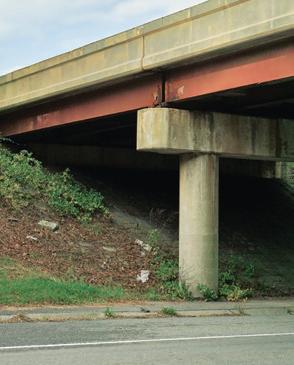

Road2Growth – INFRASTRUCTURE: the foundation to economic growth
MHCA produces a quarterly magazine, Road2Growth – Infrastructure: the foundation to economic growth, which focuses on profiling the work of the heavy construction industry, including MHCA advocacy and WORKSAFELY® news.
› Distributed to members, elected officials, senior public administrators and related stakeholder communities
› Provides current tender ads and results
› Posted online at www.mhca.mb.ca and via social media; delivered electronically every week by email
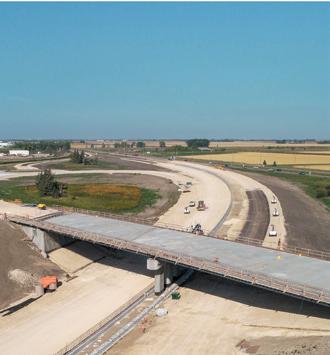
MEMBERSHIP DIRECTORY & EQUIPMENT RENTAL RATES GUIDE
› The annual MHCA Membership Directory & Equipment Rental Rates Guide is the definitive reference guide and business tool used by industry and purchasers of its services
› This “go-to” guide lists members and the full scope of the products and services they offer
› The only heavy equipment Rental Rates Guide in Manitoba
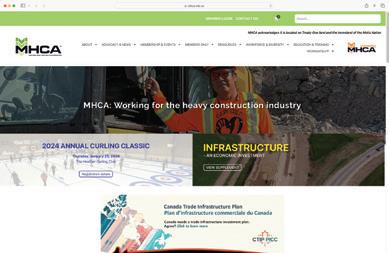
› Public and private sector project owners use the directory to contact suppliers of services, including contractors, materials, equipment, aggregates, oils, design and engineering

MHCA WEBSITE
Our website – www.mhca.mb.ca – promotes our vision, mission, services and provides members with the latest news, policy briefs and WORKSAFELY® materials and resources, including the new e-News.
Welcome New Members!
Thank you to all our current members, and welcome to our newest members!




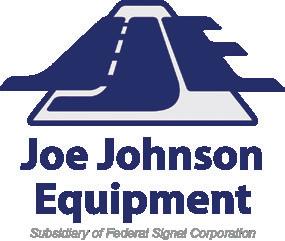



MHCA now offers 21 business courses for employers and office staff.
Inflation has increased the cost of delivering services, while high interest rates have increased the cost of borrowing, making it more costly to invest in infrastructure.”

 Enid Slack Director of the Institute on Municipal Finance and Governance at the School of Cities at the University of Toronto
Enid Slack Director of the Institute on Municipal Finance and Governance at the School of Cities at the University of Toronto
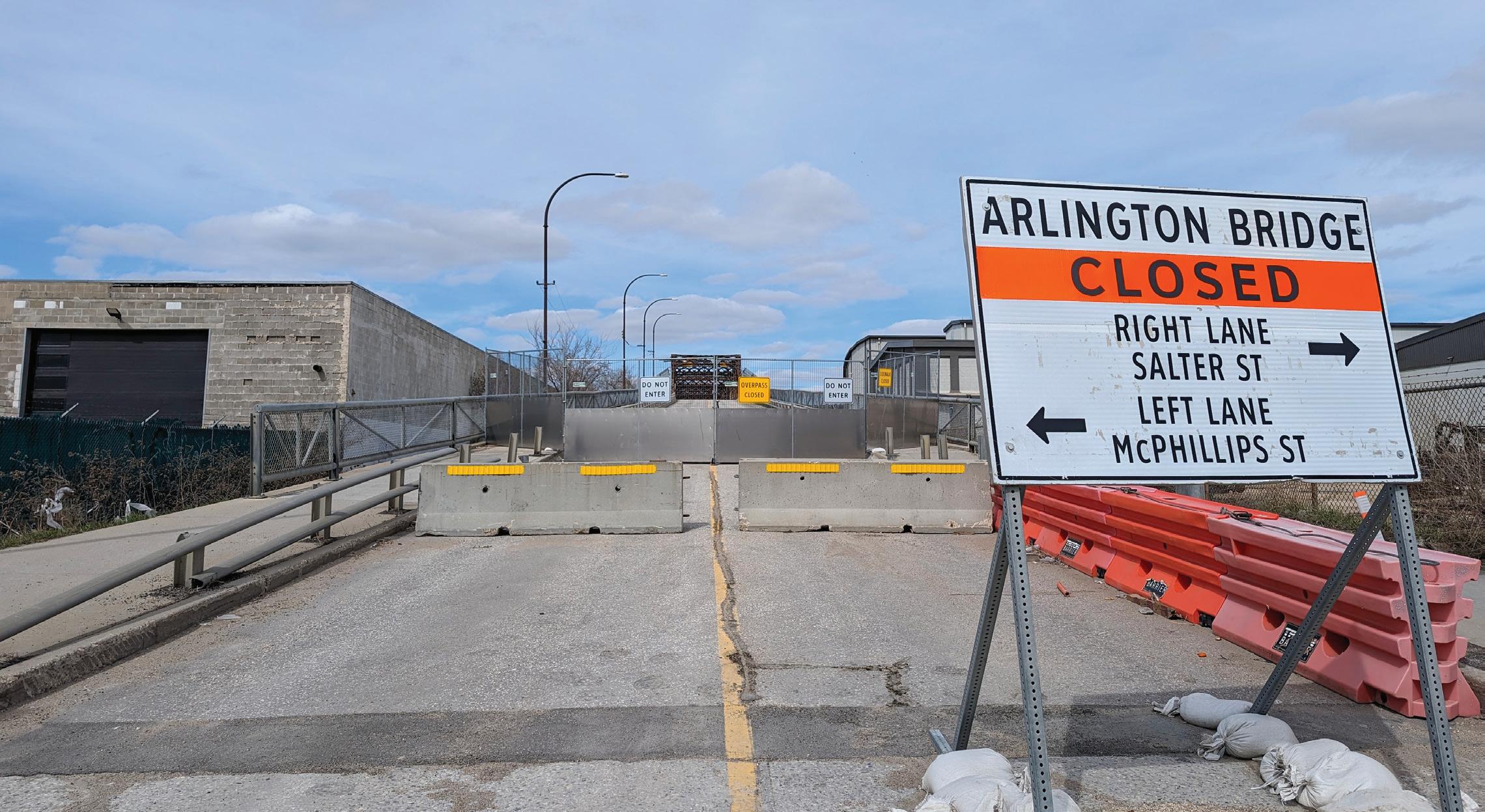
Municipalities across Canada are calling for a new fiscal deal on the grounds that their fiscal sustainability is being threatened. We have heard this call before in the 1970s and again in the 1990s and 2000s, so what is different this time?
In some ways, the situation is not all that different. Municipalities now, as then, are having trouble balancing their budgets with the limited sources of revenue available to them. Perhaps what is different this time is that municipalities are recovering from the impact of the COVID-19 pandemic on their finances and are facing a host of new and daunting challenges – hence the call for a new fiscal deal.
What are the challenges that municipalities are facing?
Inflation has increased the cost of delivering services, while high interest rates have increased the cost of borrowing, making it more costly to invest in infrastructure. These problems may be alleviated in the short term because inflation is coming down and it is likely that interest rates will decline somewhat too.
Infrastructure is deteriorating, so the cost of keeping it in a state of good
Rather than embracing short-term solutions, it is time to re-visit the structure of municipal finance – what services should municipalities be responsible for, and how should they pay for them?
repair is rising. The lack of affordable housing, increasing homelessness and the opioid crisis have put added pressure on municipal budgets, even in those municipalities that are not responsible for housing and health.
And, the impact of climate change is large and growing both in terms of paying the costs of cleanup from extreme weather events (floods, forest fires, etc.) but also the need to reduce greenhouse gas emissions by retrofitting buildings, electrifying transit, and more.
Many of these challenges are new, but the sources of revenue available to address these challenges are not. Indeed, they date back to the mid-1800s when municipalities were primarily responsible for water and roads.
Municipalities still rely mainly on property taxes, user fees and intergovernmental transfers to pay for the increasing number of services they deliver.
Since municipalities are not permitted to budget for an operating deficit, they have few options – they can cut expenditures or raise taxes and fees.
Municipalities across the country have been doing just that. Since the pandemic, many have been increasing property taxes above the rate of inflation (after not having done so for years), and some are cutting expenditures. Some municipalities have also dipped into their contingency reserves or their capital reserves to help close the fiscal gap.
Although that strategy may provide a solution in the short run, it means less money for future emergencies (such as a climate emergency) and less money to invest in keeping infrastructure in good repair.
Municipalities continue to rely on federal and provincial transfers, which increased during the pandemic. However, transfers are unstable and
Rather than embracing short-term solutions, it is time to re-visit the structure of municipal finance –what services should municipalities be responsible for, and how should they pay for them?
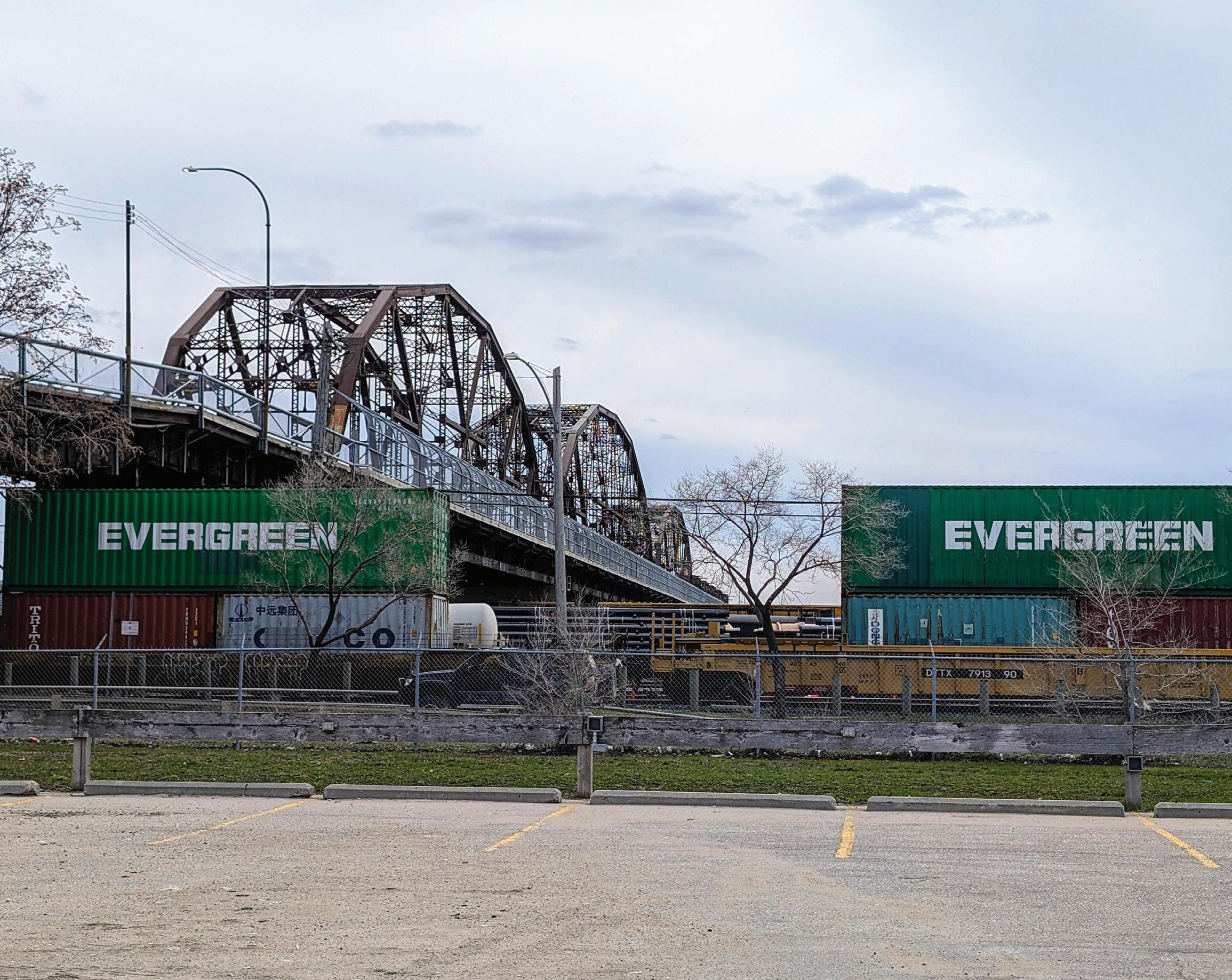
unpredictable and often have many strings attached to their use.
These options are all short-term and ad hoc and do not address the fundamental problem of the underlying municipal finance system – a mismatch between expenditures and revenues.
Rather than embracing shortterm solutions, it is time to re-visit the structure of municipal finance – what services should municipalities be
To
responsible for, and how should they pay for them?
Should municipalities be responsible for housing the homeless or immigration settlement, for example, or should these be federal and provincial responsibilities?
If the answer is that municipalities are best able to deliver these services because they are the government closest to the people, are property tax and user fees the best way to pay for these services?
address municipal fiscal sustainability, all three orders of government have a role to play. They need to come together to figure out what municipalities should be responsible for, what the other governments should be doing, and what taxes and fees municipalities should be able to levy.
Income and sales taxes have the potential to provide significant revenues to meet the challenges municipalities are facing, grow with the economy, and are arguably more progressive than the property tax. Of course, provincial legislation would be required for municipalities to be able to levy an income or sales tax, and it would also be much less costly for municipalities to piggyback onto the existing provincial system than set up their own tax administration.
To address municipal fiscal sustainability, all three orders of government have a role to play. They need to come together to figure out what municipalities should be responsible for, what the other governments should be doing, and what taxes and fees municipalities should be able to levy.
Only a structural change of this nature will solve the ongoing challenges faced by municipalities.


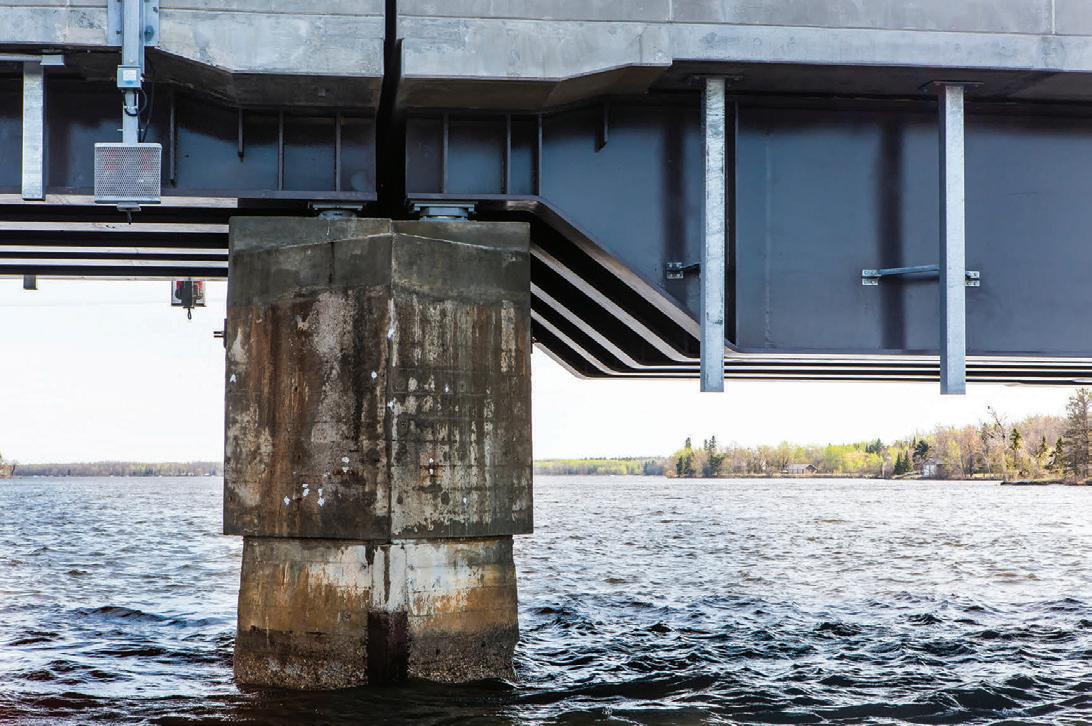


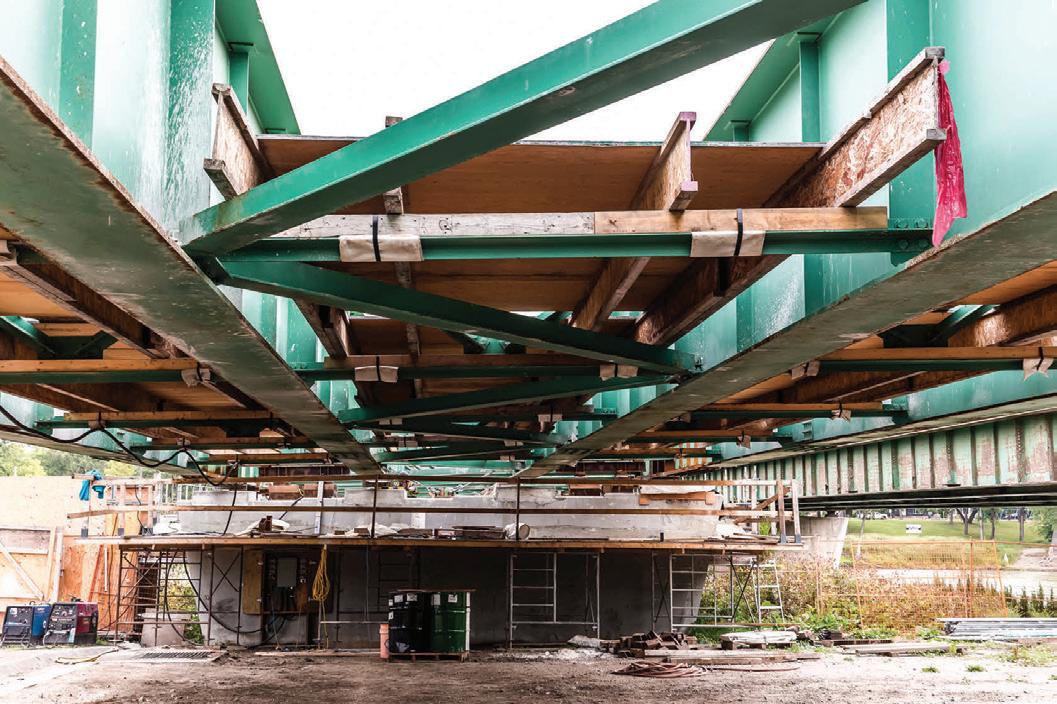



Underinvestment and volatility in Ottawa’s approach damaging Canadian trade ambitions


With reports that Canada has fallen from 10th to 26th in terms of global trade infrastructure (32nd when it comes to transportation), scaling up our trade infrastructure is essential to build supply chain capacity and fuel investor confidence.
The Canadian Construction Association (CCA) has been working in partnership with other stakeholders to strengthen the nation’s trade corridor through a Canada Trade Infrastructure Plan. With reports that Canada has fallen from 10th to 26th in terms of global trade infrastructure (32nd when it comes to transportation), scaling up our trade infrastructure is essential to build supply chain capacity and fuel investor confidence.
A recent analysis by the Canadian Centre for Economic Analysis (CANCEA) highlights the severity of the issue.
The current total annual investment in transport infrastructure (road, rail, air and water) in Canada is about $21 billion annually, or about 0.9% of GDP. To match investment levels as a percentage of GDP seen in peer countries like Australia or the UK, Canada would need to increase its annual spending by an additional $20 billion and $13 billion, respectively – more than four times the expanded total of the National Trade Corridors Fund over its entire duration.
Moreover, the volatility in investment –a staggering 3.6 times the average of its peers, ten times higher than the United States, and double that of Mexico –paints a grim picture of inconsistency and short-term thinking in policy circles.
 Rodrigue Gilbert President – Canadian Construction Association
Rodrigue Gilbert President – Canadian Construction Association
Canada’s infrastructure is crumbling under the weight of erratic investment strategies. As a nation heavily reliant on trade, the consequences of underinvestment and volatile funding are dire, potentially hindering Canada’s export ambitions and impeding economic growth.
The repercussions of this neglect are felt across industries. Over 30% of businesses identify transportation infrastructure as a significant obstacle to exporting, with certain regions and sectors reporting rates exceeding 50%. This impediment not only stifles current trade but also dampens the potential for future growth.
Short-term fluctuations in investment levels further exacerbate the issue, diminishing the return on infrastructure spending. Each additional $100 million invested in infrastructure supports a cascade of economic activity, including the creation of 15,000 jobs, $75 million in wages and salaries, and $170 million in export-related GDP activity. However, without sustained and predictable investment, the full value of these expenditures remains unrealized.
The failure to keep pace with goods exports since 2010 is particularly alarming, with infrastructure investment languishing at levels reminiscent of the 1980s. This stagnation not only undermines Canada’s competitiveness on the global stage but also threatens the integrity of critical transportation networks and utilities essential to link resources to industry, people to jobs and products to market.
What Canada urgently needs is a strategic overhaul of its approach to infrastructure investment. Rather than reactive, short-sighted measures, policymakers must embrace proactive, long-term planning that prioritizes the core principles of infrastructure development – shovel-worthy rather than shovel-ready projects. This includes not only addressing immediate deficiencies but also anticipating future needs and ensuring the resilience of essential systems in the face of evolving challenges such as climate adaptation and workforce development.
There are many benefits to such an approach. By shoring up infrastructure, Canada can enhance its trade capabilities, foster economic growth and bolster its resilience to external shocks. Moreover, by providing a stable and reliable foundation for businesses and communities, strategic infrastructure investment can unleash untapped potential and drive innovation across sectors.
The imperative for robust infrastructure investment has never been clearer. By seizing the opportunity to invest wisely and strategically, Canada can lay the groundwork for a more prosperous and sustainable future, ensuring its place as a global leader in trade and economic vitality.
Rodrigue Gilbert is the President of the Canadian Construction Association. With over two decades of government and political advisory experience, Rod is focused on driving progressive and sustainable practices in the construction industry and advocating for transformational policies to 'Build a Better Canada.'
Provincial roads, arterial highways and bridges in Manitoba are in need of work. Some are in very bad shape, making travel unsafe and costing manufacturers and producers time and money.



Nine billion dollars.
That’s the level of investment required to bring Manitoba’s roads and bridges into good working condition, and to keep the province moving as it grows.
With 53% of Manitoba’s economy based on trade, how goods are moved to and from the market in this province should be a core consideration in the government’s spending priorities and infrastructure-investment decisions.
However, provincial roads, arterial highways and bridges in Manitoba are in need of work. Some are in very bad shape, making travel unsafe and costing manufacturers and producers time and money.
This critical efficiency is directly tied to the vigour of our economy, now and in the future, as markets expand.
“Manitoba manufacturers export almost $15 billion worth of goods (68% overall share of exports) outside the province, contributing to 10% of Manitoba’s overall GDP,” Shaw notes. “Without reliable and efficient infrastructure, our economy’s growth is stagnant. Furthermore, reliable road infrastructure can attract investment and foster economic growth by facilitating trade both domestically and internationally. This leads to shipments and customer demands being met in a timely manner, which can lead to more business opportunities in and out of the province.”
A stark example of a main trade road in demonstrably poor condition is Highway 75, the single central highway that leads directly south into the US.
“About $20 billion of trade goes
Nine billion may seem like a phenomenal amount of money for a government to commit to, but the investment into good roads is greatly outweighed by the ultimate costs of bad roads.
“Roads are crucial for the health of Manitoba’s freight transportation sector,” says Terry Shaw, Regional Vice-President for the Prairies of Canadian Manufacturers and Exporters. “They ensure efficient movement of goods from manufacturers to markets. Well-maintained roads reduce transportation costs, minimize delays and improve overall logistics, thus boosting competitiveness for local manufacturers and exporters.”
The province needs to publish a report that substantially delineates the state of our highways and bridges.
north and south between North Dakota and Manitoba,” says Chris Lorenc, MHCA President and CEO. “There are sections near Letellier that are truly horrendous. But once you cross the US border, where the weather and hydrogeology are no different, the roads are phenomenally better. Where funding and investment in Manitoba is volatile, road investment in North Dakota is sustainable, predictable, and reliable.”
The issue of reliable investment in road infrastructure is not new.
“What the transportation system requires in Manitoba, in Canada, is a principled commitment to a long-term, sustained, predictable and incremental investment with measurable objectives annually reviewed for adjustment to make a genuine difference,” continues Lorenc. “We want our governments to know that we don’t want them to spend
money on our roads; we want them to invest in them, which is, in turn, an investment in the GDP.”
But what does it mean to have ‘good roads’ to achieve these growth aims?
According to Aaron Dolyniuk, Executive Director of the Manitoba Trucker’s Association, a ‘good road’ has many characteristics that need routine care and planning to be serviceable.
“Good roads don’t only mean smooth roads,” says Dolyniuk. “Good roads have shoulders wide enough for vehicles to pull over safely. Good roads are well-maintained in all seasons, but especially in the winter when roadclearing efforts are a safety requirement for all motorists. Good roads are built to a standard that accounts for climate change, so detours costing hundreds of dollars per truck aren’t necessary when there’s flooding.”
Dolyniuk stresses that trade corridors need to see improved intersections.
“Manitoba is home to important trade corridors, both east-west and north-south. As traffic volumes increase, we need more grade-separated intersections.”
What are the first steps to achieve good roads and everything they represent to the province?
“The province needs to publish a report that substantially delineates the state of our highways and bridges. We are optimistic that the Kinew government could be the first provincial government in history to give us this information,” says Lorenc. “We need transparency on the true costs of needed repairs and upkeep of this asset. We need an effective plan and to implement that plan in increments and with strategic goals in place, all while keeping the public informed.
“This is not a niche asset,” Lorenc adds.
“Everyone uses roads, whether to get to church, hockey practice, school, or work. Manitoba farmers drive their grain to the elevators and manufacturers to train depots. While our goods may travel a long way to get to us, that last and first mile is on the road.”


CAA’S WORST ROADS CAMPAIGN ADVOCATES FOR CHANGE IN MANITOBA
This grassroots approach highlights the problem areas and engages the community in discussions about infrastructure and government accountability.
Which is the worst road in Manitoba?
That’s the question CAA Manitoba aims to answer in its annual CAA Worst Roads campaign. From painful potholes to rough roadways, for the last 12 years, CAA has asked all road users across the province to nominate and vote for the roads they believe need urgent repair.
The campaign seeks to empower Manitobans by encouraging citizens to nominate and vote for the roads they believe are not meeting their expectations.
“We’re proud of this campaign’s impact over the past 12 years,” says Ewald Friesen, Manager of Government Relations with CAA Manitoba. “Our research tells us that 96% of CAA Manitoba members are concerned about the state of our roads. However, most of us vent our concerns to our spouses, co-workers or even our mechanics.
“This campaign has not only given people a voice, but it has also spurred governments into action to re-evaluate, repair and repave roads sooner than later.”
According to the 2019 Canadian Infrastructure Report Card, spending one dollar on pavement preservation may eliminate or delay spending $6-10 on costly repairs later.
Since the campaign’s inception, CAA has successfully called for dedicated year-over-year funding from all levels of government to ensure municipalities have access to the funds required to repair, rehabilitate and restore roads, bridges, curbs, cycling and pedestrian infrastructure in their communities.
Municipalities are responsible for thousands of kilometres of roads across the province. Roads, sidewalks and bike paths are only some of the things
Manitoba’s Top 10 Worst Roads for 2024 – Province-Wide
1. 18th Street, Brandon
2. Leila Avenue, Winnipeg
3. Provincial Road 307, Whiteshell
4. Kenaston Boulevard, Winnipeg
5. Provincial Highway 26, St. François Xavier
6. Empress Street, Winnipeg
7. Pandora Avenue, Winnipeg
8. Saskatchewan Avenue, Winnipeg
9. Grant Avenue and Munroe Avenue, Winnipeg
10. Inkster Boulevard, Winnipeg and Richmond Avenue, Brandon
54% of members in Manitoba have experienced vehicle damage because of poor roads with 70% paying out of pocket to repair, only 16% filing a claim with MPI and 14% forgoing repairs.
Regional Lists
Pembina Valley
1. Provincial Trunk Highway 75, Morris and Emerson
2. Provincial Road 432, Morden
3. Main Street, Winkler
Westman
1. 18th Street, Brandon
2. Richmond Avenue, Brandon
3. Park Avenue, Brandon
4. 1st Street, Brandon
5. Victoria Avenue, Brandon
Winnipeg
1. Leila Avenue
2. Kenaston Boulevard
3. Empress Street
4. Pandora Avenue
5. Saskatchewan Avenue
Thousands of people across the province voted in this year’s campaign
90% of respondents said potholes were dangerous
54% of members in Manitoba have experienced vehicle damage because of poor roads
average spend on repairs
top 10 list, Manitobans are using this platform to continue putting pressure on various government to understand what roadway improvements are important to citizens they need to be made.
• Many of these repeat offenders are either getting resurfaced, in the process of a structure overhaul or are planned to be rehabilitated.
o Potholes and poor road maintenance continue to dominate the reasons why their vote.
• potholes
• crumbling pavement
• poor road maintenance

79% of respondents cite uneven pavement as dangerous
70% pay out of pocket for repairs
• Suspension
• Misaligned steering
• Rims and tie rod ends
• Flat tires
“ Comments from the public provide insight into the size of the potholes that pose a risk to safety, some are described as being so large that they feel as if their vehicle is being swallowed within it. “
16% file a claim with MPI
43% of members in Manitoba change their driving route often to avoid a bad road
• From congestion, potholes, poor road signs and the timing of traffic lights to pedestrian and cycling safety, everyone is affected by the quality of our roadways.
• From congestion, potholes, poor road signs and the timing of traffic lights to pedestrian and cycling safety, everyone is affected by the quality of our roadways.
• With six roads from the 2023 Worst Roads list making an appearance once again on this year’s top 10 list, Manitobans are using this platform to continue putting pressure on various levels of government to understand what roadway improvements are important to citizens and where they need to be made.
• With six roads from the 2023 Worst Roads list making an appearance once again on this year’s top 10 list, Manitobans are using this platform to continue putting pressure on various levels of government to understand what roadway improvements are important to citizens and where they need to be made.
• Many of these repeat offenders are either getting resurfaced, in the process of a major infrastructure overhaul or are planned to be rehabilitated.
• Many of these repeat offenders are either getting resurfaced, in the process of a major infrastructure overhaul or are planned to be rehabilitated.
o Potholes and poor road maintenance continue to dominate the reasons why people cast their vote.
• Potholes and poor road maintenance continue to dominate the reasons why people cast their vote.
resulting in over 486 roads being nominated from 71 municipalities.
› The common issues that were brought up in this top 10 list are potholes, crumbling pavement and poor road maintenance.
› Survey conducted by CAA Manitoba shows that potholes (90%) considered dangerous CAA members in Manitoba followed by uneven pavement (79%).
› Comments from the public provide insight into the size of the potholes that pose a risk to safety, some are described as being so large that they feel as if their vehicle is being swallowed within it.
› Municipalities are responsible for thousands of kilometres of roads across the province.
› Roads, sidewalks and bike paths are only some of the things that
municipal governments fund with limited revenue sources.
› It’s important for communities to share their view on what and where investments should be made. CAA Worst Roads is a forum to do that.
Since 2012, the CAA Worst Roads campaign has provided road users across Manitoba the opportunity to nominate for roads they believe are in urgent need of repair.
› From congestion, potholes, poor road signs and the timing of traffic lights to pedestrian and cycling safety, everyone is affected by the quality of our roadways.
› With six roads from the 2023 Worst Roads list making an appearance once again on this year’s Top 10 list, Manitobans are using this platform to
continue putting pressure on various levels of government to understand what roadway improvements are important to citizens and where they need to be made.
› Many of these repeat offenders are either getting resurfaced, in the process of a major infrastructure overhaul or are planned to be rehabilitated.
› Potholes and poor road maintenance continue to dominate the reasons why people cast their vote.
With the rising costs of living, investment in roads and supporting infrastructure is more important than ever.
› Poor roads can cause damage to vehicles, impacting individuals’ finances. In fact:
› 54% of members in Manitoba have experienced vehicle damage because of poor roads with 70% paying out of pocket to repair, only 16% filing a claim with MPI and 14% forgoing repairs.
› Those surveyed say they spent $962 on average to repair their vehicle (with 50% of those surveyed paying between $500-1,999).
Damages range from:
› Suspension
› Misaligned steering
› Rims and tie rod ends (tie rod ends are a part of the steering system)
› Flat tires
› 43% of members in Manitoba change their driving route often to avoid a bad road.
Since 2012, the CAA Worst Roads campaign has provided road users across Manitoba the opportunity to nominate for roads they believe are in urgent need of repair.
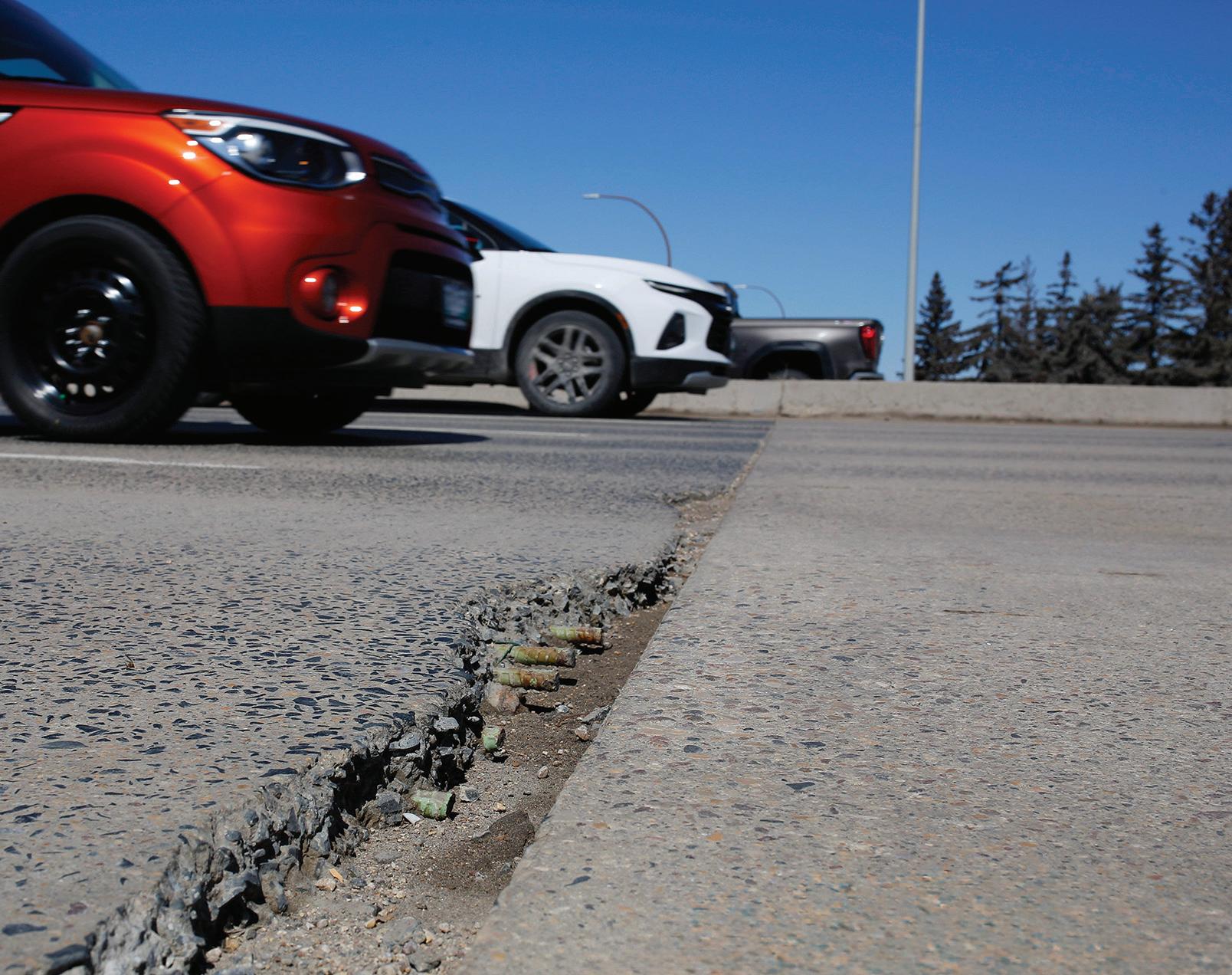
that municipal governments fund with limited revenue sources.
In 2023, Manitobans nominated 711 roads, representing most of the province’s 137 municipalities, vying to appear on the Top 10 list.
“Our research tells us that nine in ten members agree that short-term inconvenience due to maintenance work is worth the long-term improvements in roads,” adds Friesen. “We know the campaign works and have seen success stories because governments prioritize infrastructure through multi-year capital investments.”
Every year, we see governments move up road repairs for roads after appearing on the CAA Worst Roads list. Some examples of success stories include Provincial Road 307, which clinched the top spot on the list in the last two years. In 2022, 9.2 km of the highway was resurfaced. More rehabilitation work is scheduled for 2024.
In Winnipeg, construction crews worked hard on Goulet Avenue within days of our campaign reveal last year. The rehab of this road included replacing and reconstructing roadways and curbs.
In Winnipeg, construction crews worked hard on Goulet Avenue within days of our campaign reveal last year. The rehab of this road included replacing and reconstructing roadways and curbs.
Thanks to significant repairs on Saskatchewan Avenue and Empress Street, this Worst Road fell from second to ninth place in 2023.
Voted Winnipeg’s seventh worst road in 2022, Taylor Avenue in Winnipeg underwent repairs between Harrow Street and Stafford Street. The repairs included:
› Reconstructing the roadway and sidewalk
› Improving drainage and sewage
› Installing new streetlights and replacing and improving traffic signals “Our roads are the arteries used every day to keep essential workers, goods and services flowing and should be maintained more than ever. Good roads are critical to building a strong economy, and road investments create jobs,” adds Friesen.
“While we are pleased with the progress, there is still more work that needs to be done. Some usual suspects continue to make an appearance, including Saskatchewan Avenue, Empress Street, Kenaston Boulevard, and Leila Avenue.”
For more information, visit www.caaworstroads.com.

Soon after being sworn in as Minister of Transportation and Infrastructure, I had the opportunity to sit down with representatives from the Manitoba Heavy Construction Association and other industry experts. Early briefings by the department and additional stakeholder meetings described the state of disrepair the provincial highway network had fallen into after years of cuts.
That’s why, in the first budget of our new government, we made a $500-million commitment to invest in highway capital infrastructure, cost-share projects and grants supporting the development of initiatives such as Hudson Bay Railway, the Port of Churchill and CentrePort Canada. We are committed to renewing existing infrastructure, improving highway safety, developing the local economy and connecting communities and families through its transportation networks.
To guide future investment, we have established a blue-ribbon panel of local experts and leaders.
Our government’s goal is to leverage the province’s geographical location to support Manitoba’s national and global trade operations to grow the local economy and create jobs. The department’s Multi-year Infrastructure

Our government’s goal is to leverage the province’s geographical location to support Manitoba’s national and global trade operations to grow the local economy and create jobs.”
Investment Strategy focuses on four key highway investment categories: renewal, economic development, climate resiliency, and connectivity and innovation. The department is currently working on an update to the strategy, which is set to be released this spring.
It’s no secret there is much work to do. My department is focused on establishing a grid of trade and commerce routes that support the Roads and Transportation Association
of Canada loading, Manitoba’s heaviest regulated loading classification. When completed, this grid of routes will represent 36.5% of Manitoba’s allweather provincial road network.
As outlined in the 2024 provincial budget, this fiscal year Manitoba Transportation and Infrastructure plans to invest $500 million in highway capital infrastructure, supporting projects within department’s key initiatives such as the Trade and Commerce Grid, Winnipeg
One Million Perimeter Freeway Initiative and the National Economic Trade Corridor Strategy.
We are continuing large-scale projects such as twinning the TransCanada Highway between Falcon Lake and the Manitoba-Ontario border, the reconstruction of Provincial Trunk Highway (PTH) 59 from the US border to Provincial Road (PR) 403, interchange construction on the South Perimeter at St. Mary’s Road and reconstruction of PTH 75 between Ste. Agathe and Morris.
Manitoba Transportation and Infrastructure will also be providing a $30-million grant to the Arctic Gateway Group for work on the Hudson Bay Railway and the redevelopment of the Port of Churchill. This investment will contribute to Manitoba’s status as a trade hub and maritime province. Another grant fund provided to CentrePort Canada Inc. is aimed to support its growth and continuing operations. As part of its northern strategy, the department will partner with the federal government to reinstate the North/South winter road connecting the communities of St. Theresa Point First Nation and Berens River First Nation, as well as other remote communities in the region.
Following the provincial election in fall 2023, our government announced plans to establish a Blue-Ribbon Panel on Infrastructure. Co-chaired by CentrePort Canada’s Carly Edmundson and Scott Phillips, Councillor at the RM of Sifton, the panel will recommend priority projects to grow our economy and create jobs.
Panel members are drawn from First Nations, municipalities and the rail, agriculture, transportation and infrastructure sectors.
Building the blue-ribbon panel is just one part of the province’s infrastructure strategy. With its ambitious mandate, Manitoba Transportation and Infrastructure will make investments that respond to climate change and safety needs and work towards advancing reconciliation with First Nations. The province’s infrastructure strategy will grow its economy, encourage domestic and international trade, create
› Co-Chair Carly Edmundson, President and CEO of Centreport
› Co-Chair Scott Phillips, Councillor of Rural Municipality of Sifton, Association of Manitoba Municipalities (AMM) Board Member
› Victor DaSilva, Business Manager of Labourer’s International Union of North America
› Pamela Kolochuk, CEO of Peak of the Market
› Chris Lorenc, President and CEO of Manitoba Heavy Construction Association
› Joan Hardy, Former Rail and Agriculture Executive, Sat on the Strategic Corridors Advisory Committee
› Dennis Meeches, President of Tribal Councils Investment Group, Former Chief of Long Plain First Nation, Economic Development Winnipeg Board Member
› Andre Murphy, Mayor of The Pas, AMM Director
› Kam Blight, President of AMM, Reeve RM of Portage la Prairie
› Jennifer Freeman, Executive Director, Winnipeg Metropolitan Region
› Chief Larson Anderson, Norway House Cree Nation
› Chief Heidi Cook, Misipawistik Cree Nation
valuable jobs, support families, and keep Manitobans safe and prosperous. I thank my entire staff for the work they do to meet these goals.
Information on current strategic investment categories, initiatives and planned projects can be found in MTI’s Multi-Year Infrastructure Investment Strategy online at www.gov.mb.ca/mti/ myhis/index.html.
Information on project type and status can be found on MTI’s interactive projects map online at www.gov.mb.ca/mti/mipmap/ index.html.
Build your case on a strong foundation.
We have the expertise, the experience and the right tools for every job.
The Honourable Lisa Naylor is the Province of Manitoba’s Minister of Transportation and Infrastructure and the Minister of Consumer Protection and Government Services. HILLCOUNS EL .COM
A Leading Litigation Boutique For Over 36 Years.
Growing up around the heavy construction industry, Nicole Chabot naturally gravitated towards it.
“Initially, I always saw the business as just ‘being there,’ it didn’t seem exceptional or different,” Chabot says about L.Chabot Enterprises, the family business that spans three generations. “Now, I can look back and reflect on the benefit of that experience of always having the business around, and I have tremendous respect for the vision and hard work of my father and grandfather to get us to where we are,” Chabot says.
While obtaining her bachelor’s degree at the University of Manitoba, she explored various interests without a definitive direction until a conversation with her mother about new safety standards implemented in the industry led Chabot to join the family business, where she now serves as vice-president.
Majoring in English, Chabot found her literacy and critical learning skills to be a perfect fit for developing the company’s safety program.
She furthered her education with courses from Red River College and Manitoba Heavy Construction Association (MHCA), which led her to achieve an auditor certification for L. Chabot Ent. and reach COR® certification within two years.
“Even though I grew up surrounded by the family business, what drew me initially was the opportunity to be part of a legacy organization,’ Chabot says. “The challenge and excitement of working in such a dynamic and impactful industry has kept me engaged throughout my career.”
As only the second woman to chair the MCHA, Chabot notes it was a tremendous honour and responsibility.
“It’s definitely a huge source of pride for me. It’s something that I took very seriously,” she says. “I was honoured to fill the role. Being part of MHCA has been such a huge point of growth for me, personally and professionally.”
During her tenure, she aimed to make a lasting impact by advancing key advocacy issues with government and promoting diversity and inclusion within the industry.
“My experience in this leadership role allowed me to advocate for important issues and bring about positive change, not only for women but for all underrepresented groups in heavy construction,” Chabot says. “Part of my goals were to increase the diversity on our board, and we’ve definitely done that.”
Chabot has contributed significantly to the company’s growth by developing strategy and partnerships and enhancing its profile through active participation in various industry and community boards.
“I have a profound sense of responsibility for the community of people that we employ. We have a wonderful workforce, and many of them have been with us for over a decade or more.”
One of her proudest achievements is leading the team in securing and completing high-profile projects that have shaped community infrastructure, such as:
› The initial phase of Bridgwater park landfill excavation in the area that has now become Bridgwater group of neighbourhoods;
› The first phases of site development for Bishop Grandin Crossing, a multi-year endeavour moving in excess of half a million cubic metres of excavation; and
› The construction of the Traverse Bay Boat Launch, to name a few. Additionally, she has focused on

My experience in this leadership role allowed me to advocate for important issues and bring about positive change, not only for women but for all underrepresented groups in heavy construction.
– Nicole Chabot, L.Chabot Enterprises
implementing innovative strategies to improve efficiency, safety, quality and sustainability within operations.
Facing unique challenges as a leader in a traditionally male-dominated industry, Chabot emphasizes perseverance, thick skin, and the importance of earning respect. “I’ve always approached challenges as opportunities for growth. By staying true to my values, working hard, and earning the respect of my colleagues,
L. Chabot Enterprises’ inclusive culture has been integral to its operations and community involvement. She credits her dad for building the business by never excluding anyone.

I’ve been able to navigate these challenges and achieve success.”
She also humbly admits she’s had the tremendous benefit of growing up in a family business. “The barriers that might have traditionally been there for me, it must be acknowledged, were not there.”
L. Chabot Ent. is a 100% Indigenousowned business with a strong philosophy of collaboration and openness, which has led to attracting a diverse workforce organically.
“L. Chabot Ent. is deeply rooted in our values of community, respect, and environmental stewardship,” she says.
“The Indigenous background to the company – which is not just background, I mean, it’s who we are – is a huge source of pride. We operate three permanent gravel pit quarrying sites around Manitoba with CCIL Certified Aggregate Test Labs onsite, and we’re the only 100% Indigenous aggregate supplier in the capital region.”
There are many progressive companies in the industry right now, and while companies are opening up to become more inclusive and diverse, there’s still work to be done, Chabot says.
L. Chabot Enterprises’ inclusive culture has been integral to its operations and community involvement. She credits her dad for building the business by never excluding anyone. That approach has naturally attracted a diverse workforce, so much so that almost their entire trucking fleet is composed of newcomers to Canada.
On recruiting and diversity, she notes: “I think it’s all about making people understand that they are part of our community. We’re open to learning about their history, background, and culture. And we want to share ours as well.”
Chabot actively participates in several boards, including as immediate past-president of the MHCA, and on the Western Canada Roadbuilders and
Heavy Construction Association, and the Canadian Construction Association as Chair of Civil National Advisory Council.
“My dedication to industry organizations is motivated by my passion for the industry and desire to make a positive impact. By participating in these organizations, I can contribute to important discussions, share best practices and, ultimately, contribute to the voice of our industry. Having that voice, and being part of the collective voice, is so powerful.”
Chabot’s dedication extends beyond the construction industry to include past involvement with the Springfield Chamber of Commerce and current service on the Manitoba Hydro board. She balances these commitments through strong scheduling and prioritization, with a focus on supporting the community. She laughs and adds that a ‘killer’ scheduling app is also very helpful.
“It can be challenging at times, but it’s incredibly rewarding. I believe in the importance of giving back to my
community and supporting organizations that are making a difference. Whether it’s through mentoring the next generation of leaders or advocating for important issues, I’m committed to making a positive impact both within and outside of the construction industry.”
Mentorship has played a crucial role in Chabot’s career. She aims to inspire the next generation, by modelling leadership and encouraging others to seize opportunities.
“I’ve been fortunate to have many mentors and role models throughout my career, including my family members, who have been instrumental in shaping my path. As an Indigenous woman in the construction industry, I’m passionate about inspiring the next generation of leaders, particularly those from underrepresented communities. Through mentorship, advocacy, and leading by example, I hope to encourage others to pursue careers in construction and achieve their full potential.”
Her aspirations for L. Chabot Ent. are to continue its legacy of excellence and success in the heavy construction industry.
“I’m committed to leading our company forward, embracing new opportunities, and taking on projects that improve and enhance our communities,” she states.
“I hope to continue positively impacting the construction industry in Manitoba and beyond, advocating for diversity, inclusion and sustainability every step of the way.”

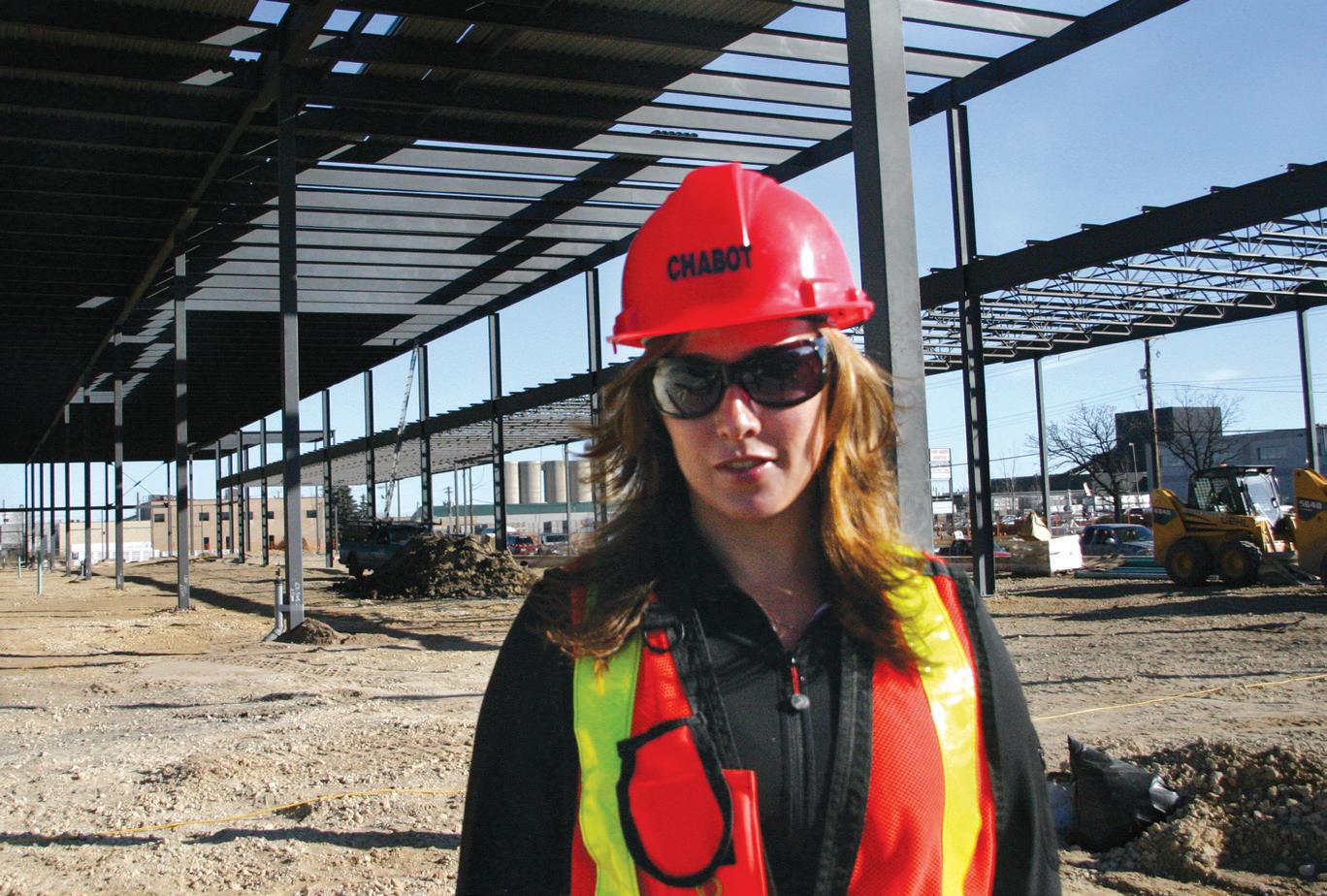



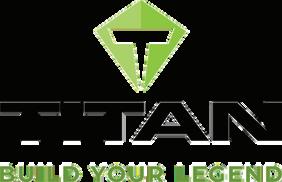

If you ask any electric vehicle (EV) owner what their biggest complaint is, chances are they will say “lack of infrastructure.” By infrastructure, they mean a need for more charging stations along highways and in communities.
However, there is another type of infrastructure that EVs, like their internal combustion engine counterparts, need, and that is good roads.
Good roads must be built and maintained to meet the needs of the communities that rely on them.
But good roads, like charging stations, need to be paid for. Here is where the increasing popularity of EVs will influence how governments raise cash to invest in transportation infrastructure, as well as the cost of keeping roads in good condition.
Provincial and territorial governments are typically responsible for paying the cost of the construction and maintenance of the region’s highway network. Municipalities repair streets and roads within their borders.
Fuel taxes, although not usually earmarked to cover this cost, are often responsible for a significant part of the provincial road network budget.

Fuel taxes, although not usually earmarked to cover this cost, are often responsible for a significant part of the provincial road network budget.
Provincial and territorial taxes on gasoline range from 6.2 cents/litre in the Yukon to 19.2 cents/litre in Québec. Drivers in Vancouver and Victoria pay 27 cents/litre and 20 cents/litre for gasoline, respectively; the rest of the BC pays 14.5 cents/litre.
In Manitoba, a fuel tax ‘holiday’ reduced the gasoline tax to zero from 14 cents/litre at the start of 2024 in response to the cost-of-living crisis faced
by many Manitobans. The provincial government plans to reinstate the tax at the end of September 2024.
Fuel taxes favour vehicles with lower fuel consumption ratings.
The tax is calculated and collected every time a vehicle is refuelled. The system is straightforward and works if all vehicles using the roads rely on a fuel that is subject to the fuel tax.
Electric vehicles, however, don’t run on gasoline, so they don’t ‘pay at the pump.’ But they are heavy because of their battery, so they contribute to road wear and tear.
EVs fall into one of three camps: hybrid-electric vehicles (HEVs) with small batteries charged by a gasolinepowered generator, battery-electric vehicles (BEVs) with large batteries that charge from mains electricity, and PHEVs or plug-in hybrid-electric vehicles, which can be charged from mains electricity or a gasoline generator.
BEVs and PHEVs run on electricity, which is not subject to the fuel tax. Consequently, EV drivers have access to the region’s roads without having to pay for their upkeep.
The problem is twofold. Most regions have not devised a fair way of taxing EVs for road use. Second, since EVs can be charged anywhere, a consistent method of tax collection based on electricity consumption can be difficult.
Jurisdictions which tax their electric vehicles often adopt an annual flat rate.
In the United States, about 32 states charge annual fees from a low of about $50 to over $200, depending on the vehicle’s weight. In Canada, Saskatchewan and Alberta have rates of $150 and $200, respectively.
The single annual fee approach is unfair to drivers who drive limited distances, such as in a city.
A fairer approach is to charge each vehicle by the distance it travels each year and its vehicle class.
For example, the most fuel-efficient gasoline vehicle in the mid-size class is the Hyundai Elantra, with a combined city-highway fuel consumption rating of 6.5 litres/100 kilometres. Using Manitoba’s road tax of 14 cents/litre, the mid-sized EV road access charge would be less than a cent/kilometre.
If an owner of a mid-sized Tesla Model S Dual-Motor drove 16,700 kilometres in a year (Manitoba’s average distance in 2021), the roadusage fee would be about $152.
An argument against EV owners paying a road-usage fee is that EVs are less polluting than internal combustion vehicles. This argument misses the point; a road fee is for the upkeep of the roads, not an environmental tax.

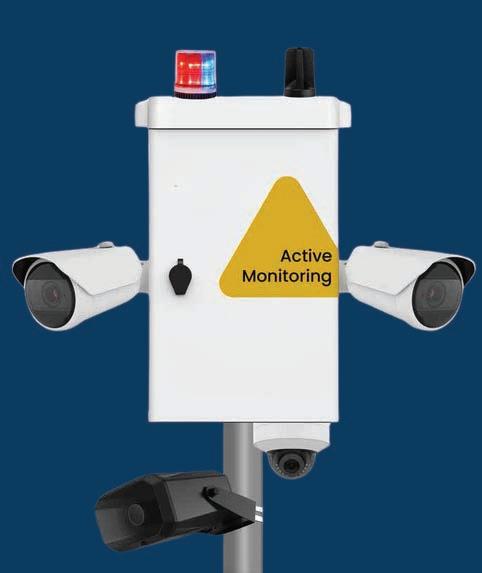

Furthermore, EVs can hardly claim to tread lightly on the province’s roads; the Tesla Model S’s gross vehicular weight (GVWR) is almost 800 kilograms more than that of a Hyundai Elantra.
Rather than vehicle class, New Zealand uses the vehicle’s weight. BEVs with a GVWR between 1,000 and 3,500 kilograms are subject to a Road Usage Charge (RUC). The RUC is 7.6 cents/kilometre for a BEV and 3.8 cents/kilometre for a PHEV. The EV RUC came into force this year when the number of EVs reached about two percent of total vehicle registrations.
HEVs do not pay the electric vehicle RUC as they already paying the RUC for gasoline vehicles.
EVs are becoming more popular in Canada. In 2023, about 10% of the vehicles sold were electric.
As the number of EVs on our roads increases and the number of conventional vehicles declines, road usage charges must be redesigned to include EVs.
If not, EV drivers will be complaining about the lack of charging infrastructure and the lack of good roads.
Additional Services:
Alarm Response
Mobile Patrols
High Visibility Security
Gatehouse Security
Visitor Safety Protocols
First aid training
Loss prevention protocols
Fire watch 24/7
Employee background checks


Mobile Fingerprints for Security Clearances
The ‘strength in numbers’ equation is solid in industry advocacy, especially for an industry that relies on long-term investment planning.
The MHCA’s advocacy gets results:
The campaign to see a national, multi-year trade corridor investment strategy has gained muscle. The Canadian Construction Association and the Canadian Chamber of Commerce included a call for a long-term funding strategy for Canada’s trade transportation network in their 2024 pre-budget submissions to the federal government.
“Canada must build and maintain trade infrastructure that dependably and efficiently transports goods to and from market. Domestic and international corridors should solidify supply chains to establish Canada as a reliable business partner,” the Chamber wrote.
The Chamber also called for increased investment in trade corridors in its February 2024 submission to the Treasury Board Secretariat on the Supply Chain Regulatory Review.
The WCR&HCA, Canadian Manufacturers & Exporters and Canada West Foundation have also continued to press for trade corridor investment. And most recently, Nova Scotia Premier Houston wrote to the Prime Minister on behalf of the Premiers’ Council of the Federation, repeating their call for a summit on strategic investment in infrastructure.
MHCA secured commitments from the provincial mines branch and the quarry rehabilitation program that contractors will be seeing speedier processing for applications and that payment for completed quarry rehabilitations would flow faster.
The provincial Natural Resources department is hiring a quarry recorder and at least two more clerks for the quarry tenure team at the branch. This follows the hiring of a quarry rehabilitation program manager earlier this year. Further, the branch is reviewing and revising policies to ensure applications are processed consistently and efficiently to avoid delays and improve compliance.
MHCA secured commitments from the provincial mines branch and the quarry rehabilitation program that contractors will be seeing speedier processing for applications and that payment for completed quarry rehabilitations would flow faster.
Work also continues on establishing the pre-cleared list for faster review periods by government agencies and First Nations communities.
This spring, MHCA assisted in seeing payment flow to contractors for some 15 quarry rehabilitation projects, some of which had been completed in six months.
MHCA and Board representatives are continuing to press senior Manitoba Transportation and Infrastructure offices for details on tendered projects for the 2024 highways capital program. MTI has said approximately 80% of the 2024 program is tendered and awarded, primarily a result of multi-year projects (planned carryover) and unplanned carryover of projects that were not started or not completed in 2023.
Industry response is that the volume of work outstanding does not match 80% of the $500-million 2024 program. MHCA further has requested a list of projects that account for the 80%, and their respective 2024 program values, and for a list of projects that will make up the remaining 20% of the program.
The MHCA is also pressing the Manitoba government to reinstate carrying over into succeeding annual budgets any unexpended amounts of an annual capital program.
The discussions are part of the MHCA’s continuing work with the department for early tendering and the publication of reliable tender ad schedules.
At MHCA’s urging, a working group to consider and recommend a long-term funding model for the City of Winnipeg’s multi-modal transportation system will be struck.
In 2023, City Council voted to include new purposes to be funded by the reserves built from the annual 2% tax hike on property. This means the revenues, once dedicated specifically to local and regional street renewal, will be spread more thinly. The working group, to report to the Public Works Committee, will look at a financing model that can bring streets to good condition while also funding other priorities such as active transportation facilities, bridge repairs, alley and sidewalk work and tree canopy restoration.

As construction season kicks into full gear in Manitoba, many of you have already set your contracts and are diving into this year’s projects. However, while you’re focused on breaking ground, it’s crucial not to overlook the fine print in those agreements.
Contracts outline the ‘rules of the game’ – who is responsible for what and where the work happens. Yet, how changes to the contract are handled can often leave employers vulnerable, a topic that was recently the subject of a great webinar I attended.
Getting change orders formally approved might seem like more paperwork, but it’s a key part of keeping a project safe. It ensures
everyone knows who’s in charge and what they’re supposed to do, even if the project changes halfway through.
A common mistake highlighted: not taking change orders seriously. Change orders are updates to the contract when the scope of the work changes. Say a road construction project needs to divert more traffic than initially planned due to unforeseen circumstances; that’s a change order. These need to be officially approved, but construction projects are dynamic, with multiple considerations on-site and have start and completion dates. Too often, in that environment, companies agree with a handshake and move on.
The first concern is that the safety of the workers on-site has been considered. However, an informal approach to accommodating the change could also become an issue should a safety incident associated with that aspect of the project occur. Without formal approval, who’s responsible for the safety of the new aspect of the project? It’s unclear, and that’s a risk no one should take. If something goes wrong, it can be tough to figure out who was supposed to ensure everything
was safe. This can lead to not only legal headaches but, more importantly, real risk to workers.
Getting change orders formally approved might seem like more paperwork, but it’s a key part of keeping a project safe. It ensures everyone knows who’s in charge and what they’re supposed to do, even if the project changes halfway through.
For instance, if a serious accident happens and what’s happening at the site doesn’t match the contract, proving that all safety measures were followed can be very hard. But if all changes are approved and documented, it’s much easier to show due diligence.
This is why it’s crucial for everyone involved in contracting to stick to the process. Improving how we handle contract changes isn’t just good practice; it’s a must for safer work sites. So next time you see a change coming, remember: a little paperwork now can make a big difference later.
 Jacquelyn Oduro Director, MHCA WORKSAFELY® Education & Training
Jacquelyn Oduro Director, MHCA WORKSAFELY® Education & Training

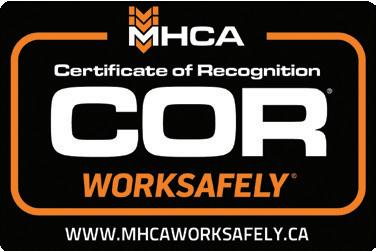
The steps to obtain COR® or SECOR® certification are as follows:
1 2 3 4 5 6
STEP ONE
› Company contacts WORKSAFELY® and completes registration form.
› WORKSAFELY® confirms WCB rate code or associate member status (annual fee due and payable if outside WCB Rate Code 407/408).
› Company registers and prepays for mandatory training.
STEP TWO
For COR® companies – one (1) senior management and one (1) full-time employee completes: Leadership for Safety Excellence and the Principles Health Safety Management courses. For SECOR companies – one (1) senior management completes: Leadership for Safety Excellence and the Principles Health Safety Management courses.
STEP THREE
After training is completed, company is issued a ‘registration’ letter, valid for a maximum of 18 months from original registration date.
STEP FOUR
With assistance of WORKSAFELY®, company assembles a safety and health manual and starts implementation (company may purchase a custom safety and health manual from WORKSAFELY®).
STEP FIVE
Prior to external audit, company must complete Auditor Training Program. Within six (6) months of completing the program, individual(s) submit trial audit for Internal Auditor Certification.
STEP SIX
With a minimum of three (3) months of consistent documentation, company requests an Audit Readiness Service from WORKSAFELY®.
Prior to the 18-month deadline, WORKSAFELY® arranges external audit and company passes and completes audit process to obtain COR® or SECOR® certification.
These companies have been verified by (and certified through) WORKSAFELY® as meeting all elements of the COR® program.
MHCA applauds all of its members who have achieved the nationally recognized COR® through any member of the Canadian Federation of Construction Safety Associations (CFCSA).
2024 – QUARTER 2 As of May 13, 2024
› Accurate Underground Utility Locating Ltd.
› Bordian Contracting Inc.
› Reliance Services (1994) Ltd.
› Tomahawk Excavation & Landscaping Ltd.
› Town of Morris


Warm weather has finally come to Manitoba, and construction season is in full swing. However, as construction begins on the busy roads, it’s important that workers who are working alongside traffic know how to work safely.
“Roadways can be very dangerous, as motorists are not always aware of their surroundings,” says Breanne Turner, OnStreet Services Supervisor with ATS Traffic in Brandon. “Public roads are always busy with rush hour traffic, hazardous work zones and commuting pedestrians. That’s a lot of moving parts to account for, and all it takes is a few seconds for things to change and go wrong.”
Turner started working in heavy construction in 2014 as a flagger. Since then, she has become passionate about safety in the industry, especially roadwork and flagging. She has earned the National Construction Safety Officer (NCSO) designation in her current role as On-Street Services Supervisor.
Overall, she has had good experiences working on the roadway. However, she has also seen drivers going too fast or disobeying flaggers.
“I’ve seen a few fender benders. The pressure on road networks due to traffic volumes is substantial,” Turner says. “I’ve seen the impact of impatient drivers, which is why it is so important to focus on enhancing traffic safety measures for all road users to get everyone home safely.”
Steve Brglez has also seen road incidents involving construction workers throughout his career.
“We’ve encountered people driving way too fast, people driving recklessly, and we’ve also dealt with drunk drivers in construction zones,” says Brglez, who co-founded and incorporated Response

Ready Inc. in 2019 with colleague André Lacroix. They have 17 and 16 years of experience in emergency response, respectively, and now offer emergency first aid, mental health first aid and ‘Stop the Bleed’ training.
“For the most part, it is distracted drivers, either texting or trying to film the accident scene as they drive past,” Brglez says.
Though workers can’t choose what kind of drivers enter construction zones, there are measures a company can take to increase on-the-job safety.
Turner believes the most important measure is for companies to have a solid safety program and a good safety culture.
“At ATS Traffic, safety is who we are,” she says. “Our team in the field are trained on standard procedures and maintain the safety competencies that our industry demands. We also take proactive steps to ensure our people maintain a safety-minded approach in all areas of our operations, especially when managing work zones on our community’s roads.
“These steps include measuring and monitoring key safety metrics and verifying our training and competencies in the field.”
It’s important for workers to be ready to respond in any situation.
“As supervisors, we assess each work zone’s complexity level and potential hazards starting at the planning stage. Our people are also trained to do fieldlevel hazard assessments to ensure they’re constantly aware of changing conditions,” says Turner. “Ensuring our people are trained, prepared and confident in their knowledge and experience is important because it will help mitigate the frequency of serious safety risks for the future.”
Steve Brglez says it’s essential that workers always wear high-visibility clothing and have a protocol in place for when an accident does occur.
“I know the Manitoba Highway Act says any roadway where the speeds exceed 80 kilometres an hour, you have to have high-visibility on, but you should have it on anyways,” he says.
“It’s also important to work in good light conditions – and important that in the case of emergency, someone guides paramedics into the scene, from the construction crew as to where they want us.”
Spectacular accidents and fatal injuries make headlines, but statistics show that the greatest risk in heavy construction is falling, getting hit by objects or being caught in objects. These incidents result most often in fractures, as well as cuts and concussions.
An analysis of WCB severe injury reports shows that we can focus on preventing those injuries and their causes to make the biggest impact on the health and safety of our workforce.
Between 2018 and 2022, approximately 395 severe injuries were recorded under WORKSAFELY®’s partner companies in the heavy construction industry, with 248 (63%) qualifying as 10-day severe injuries.
The construction sector, particularly roadwork and equipment contracting, recorded the highest number of severe injuries.
Note: These numbers represent non-COVID-19 severe injuries (when including COVID-19 injuries, they are significantly higher.)

A serious incident is defined as one:
› In which a worker is killed
› In which a worker suffers:
› An injury resulting from electrical contact
› Unconsciousness as the result of a concussion
› A fracture of the skull, spine, pelvis, arm, leg, hand or foot
› Amputation of an arm, leg, hand, foot, finger or toe
› Third-degree burns
› Permanent or temporary loss of sight
› A cut or laceration that requires medical treatment at a hospital
› Asphyxiation or poisoning
› Or that involves:
› The collapse or structural failure of a building, structure, crane, hoist, lift, temporary support system or excavation
› An explosion, fire or flood
› An uncontrolled spill or escape of a hazardous substance
› The failure of an atmospheresupplying respirator
The most frequent severe injuries are fractures, cuts and concussions, with fractures accounting for a substantial percentage of incidents. This contrasts with the nature of 60-day severe injuries, predominantly sprains and strains, which suggest different underlying causes and possibly different prevention strategies.
Roadwork and equipment contracting are sectors that are particularly prone to 10day severe injuries. Construction trades helpers and labourers, transport truck
drivers and heavy equipment operators are the occupations most affected.
The Nature: Fractures and open wounds are the most common nature of severe injuries, requiring immediate and substantial medical treatment.
The Event : The leading events causing injuries include being struck by objects, falling on the same level and getting caught in or between objects.
The Source: Structures and surfaces, parts and materials, and machinery are the primary sources of these injuries.
The Body Part : Fingers, parts of the trunk and ankles/feet are the most frequently injured body parts, underscoring the need for targeted protective measures.
Understanding the sectors and occupations at the highest risk, WORKSAFELY® can tailor its services and training programs specifically to address these areas. This targeted approach ensures that preventive measures are aligned with the most common types of injuries and the specific conditions of the sectors most affected.
Our initiative aims to not only respond to incidents but also prevent them by providing strategic education and resources that focus on the safety practices with the greatest impact. Through collaboration with industry stakeholders and continuous monitoring of injury trends, WORKSAFELY® is committed to adapting its services to meet the evolving needs of the heavy construction industry and reduce the frequency of severe injuries.
Use SiteDocs on your phone, tablet, or the web for all your safety documentation.

With eCOR®, there’s no need to collect and submit any paperwork to our auditors.

it came
to do our audit, everything was right there. There was no digging for missing forms or going out on jobsites to find them or even printing them."
– Curtis Bachmeier, Director, Wildcard Excavation Inc.
Try It Out
1. Download SiteDocs from the App Store or Google Play
2. Login: ecor@sitedocs.com Password: Activate Your Account
1. Contact info@sitedocs.com, 1-866-871-1892
2. Includes account customization, training, and free import of additional MHCA documents ®


Roadside construction sites are hazardous by nature. Inattentive or inconsiderate motorists make it even riskier for those who repair our highways, streets and underground services and utilities.
Roadside construction sites are hazardous by nature. Inattentive or inconsiderate motorists make it even riskier for those who repair our highways, streets and underground services and utilities.
Mike Burtnick has been in the roadside safety business for more than a quarter century, so he has a good perspective of how things have changed – some improvements but also greater hazards to roadside workers just trying to get on with their daily jobs.
Burtnick, Safety Manager at Maple Leaf Construction, says industry’s efforts through training, more flaggers onsite
and high-visibility clothing and signage have gone a long way to keep cars at a safe distance from construction workers and equipment.
But motorists are also dealing with more distractions than 25 and 30 years ago.
“Back in the 1980s, your vehicle had a radio in it, and that was about it,” he says.
Today, vehicles are equipped with big screen panels, which allow multiple functions, including various entertainment platforms, vehicle and journey information and external communication.
And Burtnick still sees drivers engaging in one of the most hazardous
forms of distraction – holding a cell phone to an ear, despite the fact that “every new vehicle has hands-free” cellphone connections.
The veteran heavy construction safety specialist’s first-hand experience underscores the vital need for the construction industry to constantly remind the public to slow down, drive cautiously and respect workers who are on the job, in a traffic lane, at the roadside or in other public rights of way during construction season.
For the past two decades, Manitoba’s SafeRoads campaign has worked to


We know that our campaigns, including media advertising and billboards, have raised awareness of the hazards to workers who are just doing their jobs, on public rights of way – ditches, roadside and other areas near roads and highways,
– Chris Lorenc, MHCA President and CEO
raise awareness among motorists about their responsibilities in protecting roadside construction, utility or emergency workers.
“We know that our campaigns, including media advertising and
billboards, have raised awareness of the hazards to workers who are just doing their jobs, on public rights of way –ditches, roadside and other areas near roads and highways,” MHCA President and CEO Chris Lorenc said.
Lorenc is also Chair of the provincial SafeRoads Committee, which brings together representatives of government, utilities, the construction sector and safety programs such as MHCA’s WORKSAFELY® and Winnipeg Construction Association’s CSAM.
In Winnipeg, the committee and public officeholders kicked off the campaign for the 2024 construction season in May on the theme that construction workers are ‘not in your way – they are working.’
A companion news conference was held in Brandon, with committee members and local public officeholders joining.
The campaign has shown results, but surveys also underscore the need to stay at the message.
More than 80% of respondents to a survey about SafeRoads public advertising said they consider the safety of road construction workers when driving through a construction zone, with 58% considering it every time.
Notably, those who have seen the campaign are much more likely to consider workers’ safety, with 88% of those aware of the campaign thinking about safety very often, compared to 78% who haven’t seen it.
Yet the survey also showed frustration with road construction remains high, averaging 3.1 out of 5, with 36% of respondents feeling frustrated. This sentiment is even more pronounced in Winnipeg, where 41% report frustration, compared to 28% outside Winnipeg.
Perhaps more worrisome, about 32% of respondents frequently observe drivers speeding through construction zones. This underscores the ongoing need for vigilance.
Burtnick’s experience reflects the data.
Drivers engage in dangerous behaviours, such as bumping flaggers or trying to push through queued lines of stopped traffic by driving up the shoulder.
“They are providing services upon which a functioning society depends,” Lorenc notes.

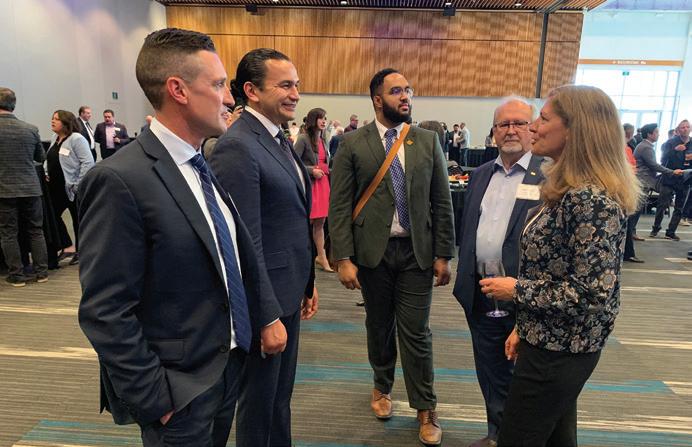




Thank you to our sponsors!




 BYRNE
BYRNE

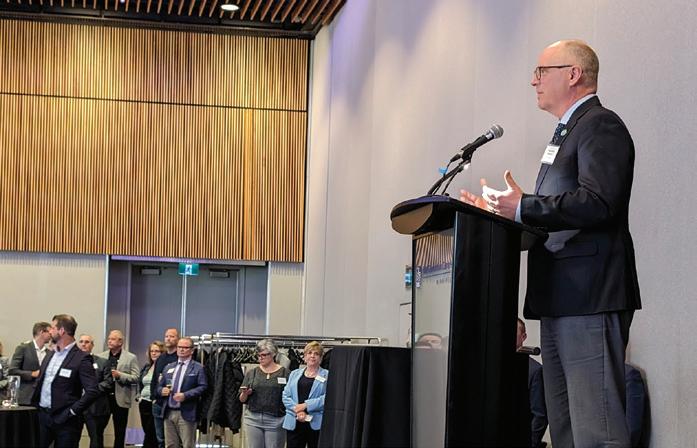












Thank you to our sponsors!







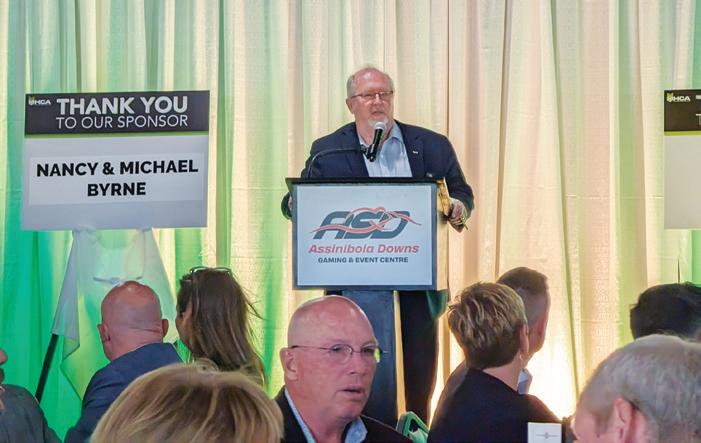




ESG stands for Environmental, Social, and Governance. It is a set of practices and standards used to evaluate a company’s performance outside its balance sheet. ESG criteria assess how well a company manages important, non-financial aspects that can impact its long-term financial health.
Already a priority for some sectors, it is beginning to touch the construction industry in Manitoba. So, what is it?
The environmental aspect of ESG evaluates a business’s impact on the environment. For construction companies,
this includes factors such as energy usage, carbon emissions, recycling on job sites and material sourcing. Construction and development activities have a clear connection with, and impact on, the environment. As a result, the environmental pillar of ESG has become a key focus in the construction industry, particularly concerning the use of eco-friendly materials, adopting energyefficient technologies and implementing sustainable construction practices.
Social responsibility concerns how a company manages its relationships with employees, suppliers, customers and
the communities where it operates. Key aspects include human rights, diversity, equity and inclusion, health and safety, employee training, labour standards and how these issues are addressed throughout the company’s supply chain.
Good governance practices ensure that companies are managed ethically and transparently. Governance factors in ESG can encompass a range of practices, such as anti-fraud and antibribery measures, pay equity, legal compliance and cybersecurity. By implementing compliance programs with robust governance standards, companies can mitigate risks, ensure regulatory compliance and uphold ethical business practices.
In recent years, ESG has gained significant traction across various industries, and ESG considerations are becoming more prevalent in procurement policies and supply chain practices that affect the construction industry.
The City of Winnipeg’s Sustainable Procurement Action Plan is one example where provisions emphasizing community and social benefits may be incorporated into City of Winnipeg RFPs and construction tenders.
So, what does ESG look like in action?
A construction company’s ESG program should encompass all aspects of its business and operations, from procurement to supply chain management to hiring and workforce practices. Examples of ESG activities can include:
› Using sustainable design, engineering and construction methods
› Ensuring the ethical sourcing of materials and verifying labour standards for all subcontractors and suppliers
› Developing a supplier code of conduct
› Planning and reviewing logistics to reduce mileage and emissions
› Making energy-efficient choices for equipment and assets
› Implementing diversity and inclusion training programs
› Ensuring pay equity among employees
› Establishing cybersecurity measures to protect sensitive data Consider developing a company code of conduct as a starting point for integrating ESG into your business. A code of conduct sets out the standards the company expects from its employees and management, including ethical standards such as integrity and transparency. It can serve as the framework for developing future ESG policies and procedures.
As ESG concerns continue gaining momentum in the construction industry, companies that proactively adopt ESG policies now are likely to find it easier to comply with future government programs and regulations later.
Embracing ESG principles can also offer tangible benefits for construction companies. By integrating sustainable practices into every stage of a project’s lifecycle, companies can reduce their environmental impact, increase operational efficiencies and mitigate potential risks. Incorporating social responsibility policies can foster a healthy work environment and a positive workplace culture and strengthen relationships with
stakeholders. Good governance practices can also help safeguard against costly fraud and data breaches. By integrating ESG considerations throughout their operations, construction companies can pave the way toward a more sustainable and inclusive future.
Note: This article is of a general nature only and is not presented as a comprehensive review of the law or as being exhaustive of all possible legal rights or remedies. This article is not intended to be relied
upon or taken as legal advice or opinion. Readers should consult a legal professional for specific advice applicable to their own circumstances. We would be pleased to discuss this with you in greater depth.
Pitblado Law is a full-service law firm. For 140 years, we have helped our clients navigate complex legal matters with skill and professionalism. Laura Balagus is an Associate with Pitblado Law, specializing in corporate and commercial law.
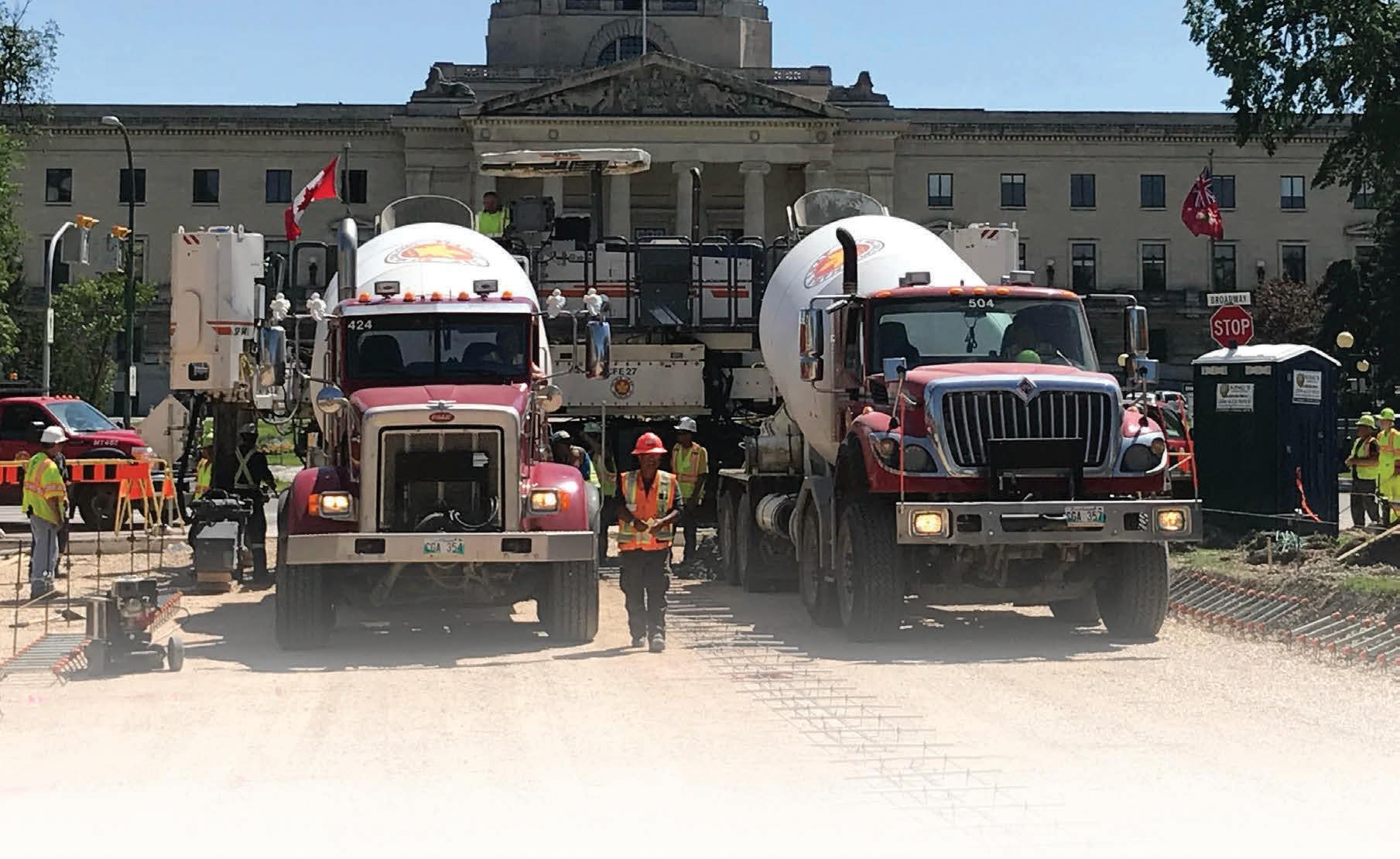



• Aggregates
• Concrete
• Diamond Grinding & Maintenance
• Highway Paving
• Material Recycling
• Product Sales
• Rural Construction
•

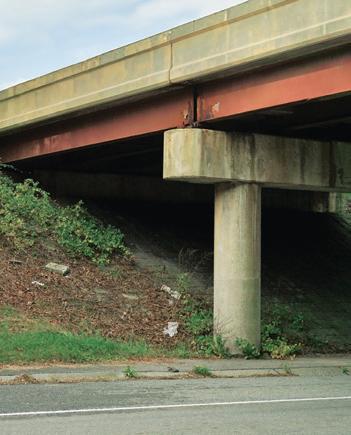
is made possible by the companies below who convey their important messages on our pages. We thank them for their support of MHCA and its publication and encourage you to contact them when making your purchasing decisions. To make it easier to contact these companies, we have included the page number of their advertisement, their phone number, and, where applicable, their website.


